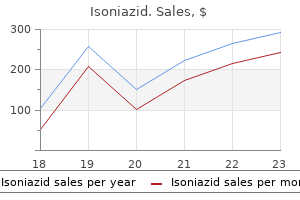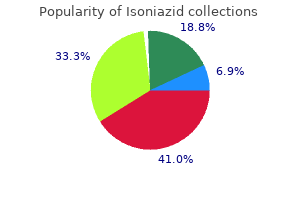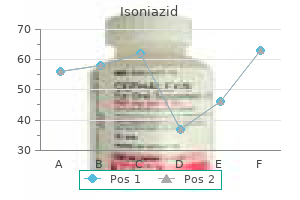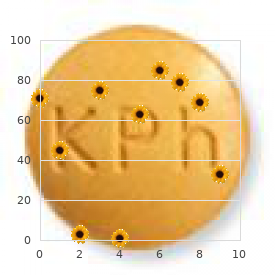Michael D. Kraft, PharmD, BCNSP
- Clinical Associate Professor, Department of Clinical Pharmacy, University of Michigan College of Pharmacy
- Assistant Director�Education and Research, Department of Pharmacy Services, University of Michigan Hospitals and Health Centers, Ann Arbor, Michigan

https://scholar.google.com/citations?user=7opVdJcAAAAJ&hl=en
Isoniazid dosages: 300 mg
Isoniazid packs: 60 pills, 90 pills, 120 pills, 180 pills, 270 pills, 360 pills

Isoniazid 300 mg order without prescription
In the United States and many different international locations, well being care suppliers are mandatory reporters for suspected abuse or neglect. Clinicians who report suspected elder mistreatment in good faith are sometimes shielded from liability or retaliation. Increasingly, urologists and other urologic well being care suppliers are seeing older adults on an ongoing basis for remedy of chronic conditions. Therefore these clinicians may be in a wonderful place to identify potential abuse and neglect amongst aged sufferers. A variety of kinds of aged mistreatment have to be thought-about, including bodily abuse, emotional and psychological abuse, sexual abuse, financial exploitation, and neglect by caregivers or self-neglect. A careful history and bodily examination are important to diagnose and document suspected elder mistreatment. Ideally, the interview and examination ought to be performed privately with the older adult, however this might be troublesome, notably if the patient has impairments in cognition, imaginative and prescient, speech, or hearing. Providers have to be alert to potential indicators of abuse or neglect including overall look; poor hygiene; distractions or nervous interactions, particularly with accompanying caregivers; or social withdrawal and avoidance of questions. Other physical indicators of abuse and neglect embody bruises, abrasions or lacerations, or bodily findings which are out of proportion to the described mechanism of injury. A careful genitourinary and pelvic examination ought to be performed in instances of suspected sexual abuse, and screening for sexually transmitted infections should be thought-about. Identification of sexual mistreatment of older adults is particularly within the realm of urologic care. It is defined by the National Center on Elder Abuse as "nonconsensual sexual contact of any type" (U. Clinicians should be alert for signs and signs of sexual abuse together with genital lacerations or other accidents, unusual or unexpected infection patterns including sexually transmitted infections, and avoidance habits or concern on the a half of the affected person. Changes from prior noticed conduct may be notably noticeable if the clinician has been following an older adult affected person longitudinally over time.
300 mg isoniazid buy with mastercard
Most protocols embody this combination every 3 months for 18 to 24 months after the initial diagnosis, then each 6 months for the next 2 years, and then annually, resetting the clock with every newly identified tumor (Fitzpatrick, 1993). Although the accuracy of each exams relies on subjective and operator-dependent interpretation of seen findings, their traditional presumed status as the gold commonplace has been extensively accepted (Brown, 2000). CystoscopicSurveillance Office-based cystoscopy offers speedy, relatively painless visible access to the urothelium. The position of cystoscopy as a gold normal in most cancers detection has come underneath scrutiny with the emergence of tumor markers and the event of newer endoscopic expertise together with fluorescence cystoscopy as described beforehand (Kriegmair et al, 1996a, 1996b; Filbeck et al, 1999; Kriegmair et al, 1999). Nevertheless, for office-based prognosis it permits identification of the site and characteristics of most tumors. There is a excessive positive predictive value with cystoscopy as a outcome of most lesions believed to be malignant are proven so pathologically. Newer digital chip cystoscopes supply related tolerability however markedly better visualization owing to readability and magnification on video displays. Complete visualization of the bladder mucosa is possible in a matter of seconds in most patients. Their high-resolution imaging obviates the only potential advantage of rigid cystoscopy (slightly higher optics than fiberoptic flexible scopes). Thus, versatile cystoscopy has basically changed inflexible cystoscopy for surveillance in males in North America and may achieve this in girls. The overwhelming majority of both men and women tolerate office-based cystoscopy with minimal discomfort. Intraurethral injection of local anesthetics is kind of universal among urologists despite a paucity of knowledge to help the practice. Considering the truth that anesthetic agents can partially cloud visualization, this ubiquitous follow ought to be reconsidered.

Purchase 300 mg isoniazid overnight delivery
Standardized evaluation of frequency and severity of issues after robot-assisted radical cystectomy. Laparoscopic transvesical excision and reconstruction in the management of mid-urethral tape mesh erosion and stones across the bladder neck: preliminary experiences. Removal of long, complex foreign bodies from bladder using single laparoscopic port under pneumovesicum. Laparoscopic elimination of a broken sewing needle in a patient with irritative bladder symptoms. Laparoscopic removing of intravesical mesh following pelvic organ prolapse mesh surgical procedure. Laparoscopic transvesical elimination of erosive mesh after transobturator tape process. In uncommon cases, gastrointestinal segments may operate as urethral or vaginal substitutes. The abdomen, jejunum, ileum, and colon all have a task in urinary tract reconstruction. Successful use of intestinal segments requires an intensive data of their surgical anatomy. The surgeon must know the methods of preparing the intestine for an operation and the techniques for isolating segments of gut and reconstituting continuity of the enteric tract. Crucial to success is an understanding of the technical procedures and potential problems of incorporating the intestine into the urinary tract. With this data, reconstruction of the urinary tract could also be performed with the correct section of intestine within the least morbid way. This chapter reviews the technical aspects involved in using intestinal segments in urologic surgical procedure that pertain to all types of reconstructive procedures and describes the necessary potential acute and long-term difficulties and complications of the use of intestinal segments. The bacterial inhabitants in the stomach is relatively low, however within the remaining segments of the bowel including the jejunum, ileum, and colon, there are excessive bacterial counts. Early studies instructed that bowel anastomoses in patients whose intestinal tract had not been ready before surgery had increased wound infection rates, increased intraperitoneal abscesses, and an anastomotic dehiscence price larger than in sufferers who obtained proper bowel preparation earlier than surgery (Irvin and Goligher, 1973; Dion et al, 1980).

Isoniazid 300 mg purchase fast delivery
Catheterization could be discontinued when environment friendly voiding has resumed, which is usually indicated by a postvoid residual quantity either less than a hundred mL or lower than 30% of the functional bladder quantity. Often, tying the suspension sutures is sufficient to stop this bleeding, however when it persists, drainage of the retropubic house is indicated. The drain is normally removed on the primary to third day, when minimal output is noted. The proximal, or bladder neck, suture regularly must be handed by way of the insertion of the rectus abdominis muscle. Additional sutures might or may not be placed between the anterior bladder wall and the rectus muscles to pull the bladder farther anteriorly. The Burch colposuspension was a novel strategy to restore the urethrovesical junction to a retropubic location by approximating the periurethral fascia to the robust bands of fibrous tissue running along the superior side of the pubic bone (Cooper [iliopectineal] ligament) with three pairs of sutures. The original Burch retropubic colposuspension is acceptable provided that the patient has sufficient vaginal mobility and capability to permit the lateral vaginal fornices to be elevated toward and approximated to the Cooper ligament on either side. This achieved broad help for the urethra and bladder neck and probably minimized the chance of postoperative voiding dysfunction. Two to 4 sutures are placed on all sides, each suture taking a good bite of fascia and vaginal wall, with care taken not to move via the vaginal mucosa. Some suggest taking double bites of tissue to lessen the danger of suture pull-through (Jarvis, 1994a). The most distal suture is at the stage of the bladder neck and positioned no closer than 2 cm lateral to it, although some place distal sutures at the mid-urethral degree (Tanagho, 1978). Subsequent sutures are placed proximal to the level of the bladder neck, at about 1-cm intervals. The sutures are then placed into corresponding websites in the Cooper ligament, the emphasis being on a mediolateral direction for the sutures.

Generic 300 mg isoniazid mastercard
The aims of surgical administration embrace restoration of regular vaginal anatomy while sustaining and doubtlessly restoring visceral and sexual function. This is the art of tailoring the appropriate therapy for each individual surgical affected person. The bones of the pelvis present the scaffold on which the soft-tissue helps (muscles, ligaments, and fascia) are anchored. The innominate bones are further divided into the ileum, the ischium, and the pubis. The obturator foramen is shaped by the superior pubic ramus above, the pubic physique and inferior ramus medially, and the anterior border of the ischial physique below (Newell et al, 2005). The pelvic floor consists of all of the gentle tissues that basically hold the pelvic viscera in place, including the muscular support, the fascial and ligamentous help, and the connective tissues. The pelvic floor is a threedimensional construction that features as a unit (Hurt, 2000). The pelvic diaphragm is composed of the levator ani muscular tissues (which include the striated pubococcygeus and iliococcygeus muscles) and coccygeus muscular tissues. The coccygeus can be termed the ischiococcygeus muscle and is attached medially to the lateral margins of the coccyx and fifth sacral section (Mundy, 2005) and laterally to the ischial backbone. The iliococcygeus is attached to the ischial backbone and the arcus tendineus levator ani laterally and the tip of the sacrum and coccyx posteriorly. In each women and men, fibers of the pubococcygeus attach to the perineal physique (Mundy, 2005) the pubococcygeus compresses the visceral canals, which cross the pelvic floor. The puborectalis portion of the pubococcygeus helps to create the anorectal angle. Contraction of the puborectalis causes the rectoanal junction to move toward the pubic symphysis, which is critical in sustaining fecal continence (Rogers, 2003). Although the muscles are referred to individually, like other constructions of the pelvic flooring, the boundaries are often tough to delineate and they perform similar physiologic capabilities (Mundy, 2005).

300 mg isoniazid with mastercard
Adverse occasions had been very common, however complete decision of all fistulae was achieved in 55%, and 50% discount in fistulous drainage was achieved in 68% of patients on 5-mg infliximab. The objective of operative administration is to separate and shut the concerned organs with minimal anatomic disruption and regular long-term function of both methods. Unfortunately, enterovesical fistulae could also be complicated by intense pelvic inflammation, pelvic abscess, and phlegmon formation (in some cases), requiring complicated staged reconstructions (Shackley et al, 2000). Bowel resection and/or partial cystectomy may be necessary to obtain viable tissue margins to guarantee sufficient, watertight closure of the involved viscera. An interpositional flap of higher omentum is often placed between the repaired bowel and urinary bladder to forestall overlapping suture traces and provide a well-vascularized floor for therapeutic. Both single and multistage procedures have been advocated, depending on the clinical circumstances (Morse and Dretler, 1974; Castro, 1975; Ray et al, 1976; Morrison and Addison, 1983; Mileski et al, 1987; Pollard et al, 1987; Rao et al, 1987; Shackley et al, 2000; Walker et al, 2002; Najjar et al, 2004). A one-stage procedure involves elimination of the fistula, closure of the involved organs, and primary reanastomosis of the bowel after resection of the involved bowel phase. A two-stage method advocates elimination of the fistula, closure of the involved organs, and creation of a short lived proximal diverting colostomy, with a later return to the working room for colostomy takedown as soon as the fistula tract has been demonstrated to be closed. Patients with an inflammatory cause of the fistula however without gross contamination could be treated with a one-stage procedure, whereas these with an unprepared bowel, gross contamination, or abscess may require a multistage process (Mileski et al, 1987; Shackley et al, 2000). As noted beforehand, most sufferers with colovesical fistulae present themselves electively with lower urinary tract signs, not emergently in extremis with sepsis (Mileski et al, 1987). Therefore adequate preoperative support, together with bowel preparation, nutritional supplementation, and applicable antibiotics, can be utilized within the majority of patients, permitting an elective one-stage approach. More latest sequence have tended to indicate a greater advocacy of the one-stage strategy; Garcea and colleagues in a collection of ninety sufferers with colovesical fistula reported major anastomosis in 61 of 65 (94%) cases wherein left colon resection was undertaken (Garcea et al, 2006). Balaguera and colleagues argued towards diverting colostomy or Hartmann process as being unnecessary, and presumably bringing further morbidity (Balaguera et al, 2006). Shackley and colleagues described a series of 10 patients with highly advanced fistulae involving three to six separate organs and surfaces (Shackley et al, 2000). Laparoscopic management of colovesical fistulae has been reported, albeit with a relatively excessive fee of conversion to open restore (Joo et al, 1997). Several reports have described a laparoscopic approach to one-stage remedy of colovesical fistulae, together with a complete of 30 sufferers (Serizawa et al, 1996; Menenakos et al, 2003; Pokala et al, 2005; Tsivian et al, 2006). UreteroentericFistula Fistulae between the ureter and the bowel are more than likely to occur in the setting of inflammatory bowel illness corresponding to Crohn disease.
Diseases
- Rubella, congenital
- 2-Hydroxyglutaricaciduria, rare (NIH)
- 49, XXXXY syndrome
- Sweatalitus disease
- Loose anagene syndrome
- Deafness conductive ptosis skeletal anomalies
- Xeroderma pigmentosum, type 7
- Hyperphenylalaninemia
- Chromosome Chromosome 1
Isoniazid 300 mg order overnight delivery
Mycobacterial cell wall extract for therapy of carcinoma in situ of the bladder. Intracavitary bacillus Calmette-Gu�rin in the remedy of superficial bladder tumors. Dose-response of bacillus CalmetteGu�rin in the treatment of superficial bladder most cancers. Superficial bladder most cancers: for a way lengthy should a tumour-free affected person have examine cystoscopies Bacillus Calmette-Gu�rin plus interferon-alpha2B intravesical therapy maintains an extended treatment plan for superficial bladder most cancers with minimal toxicity. A randomized trial of intravesical doxorubicin and immunotherapy with bacille Calmette-Gu�rin for transitional cell carcinoma of the bladder. Keyhole limpet hemocyanin immunotherapy of bladder most cancers: laboratory and medical studies. Long-term follow-up of preliminary Ta grade 1 transitional cell carcinoma of the bladder. Economic and humanistic penalties of preventable bladder tumor recurrences in nonmuscle invasive bladder cancer instances. Efficacy and safety of photodynamic remedy for recurrent, excessive grade nonmuscle invasive bladder most cancers refractory or illiberal to bacille Calmette-Gu�rin immunotherapy. The role of pathology review of transurethral bladder tumor resection specimens within the trendy era. Urothelial carcinoma within the prostatic urethra and prostate: current controversies. New optical imaging applied sciences for bladder cancer: concerns and perspectives. Flexible cystoscopy assisted by hexaminolevulinate induced fluorescence: a brand new approach for bladder most cancers detection and surveillance Bladder tumor markers past cytology: International Consensus Panel on bladder tumor markers. Tumors at the bladder neck might require resection into the prostatic urethra: higher tract urothelial tumor after transurethral resection for bladder tumor.

Cheap isoniazid 300 mg with mastercard
This could additionally be completed by suturing the posterior peritoneum to the serosa of the conduit above the ureterointestinal anastomosis. I choose to drain the ureterointestinal anastomosis with a Jackson-Pratt or Blake closed-suction drain laid in the retroperitoneum three to 4 cm away from the anastomosis. For patients with severe respiratory illness, consideration ought to be given to performing a gastrostomy. All patients have sequential compression boots applied as prophylaxis for pulmonary embolus. Metabolic issues are the outcome of altered solute reabsorption by the intestine of the urine that it accommodates. Many of those complications are a consequence of altered solute absorption across the intestinal section. The elements that affect the amount of solute and kind of absorption are the section of bowel used, the floor space of the bowel, the amount of time the urine is uncovered to the bowel, the concentration of solutes in the urine, the renal function, and the pH of the fluid. Electrolyte Abnormalities Serum electrolyte problems and the type of electrolyte abnormalities that occur are totally different, relying on the segment of bowel used. If jejunum is the segment used, hyponatremia, hyperkalemia, and metabolic acidosis happen. Other electrolyte abnormalities that have been described embody hypokalemia, hypomagnesemia, hypocalcemia, hyperammonemia, and elevated blood urea nitrogen and creatinine. The metabolic alkalosis every so often may be extreme and lifethreatening (syndrome of severe metabolic alkalosis) (Table 97-10). Patients are often successfully treated with an H2 blocker to reduce proton secretion by the gastric segment and rehydration. In life-threatening circumstances, arginine hydrochloride infusion has been used to rapidly restore acid-base balance. On occasion, when H2 blockers are ineffective, the proton pump blocker omeprazole has been successfully used. Rarely, omeprazole is ineffective, and if the life-threatening metabolic alkalosis persists, the gastric phase should be eliminated (Gosalbez et al, 1993).

Cheap isoniazid 300 mg
Conservative treatment of chosen patients with colovesical fistula because of diverticulitis. Surgical administration of urethral injury in neurologically impaired female patients with persistent indwelling catheters. Indwelling double-J ureteral stents for momentary and everlasting urinary drainage: expertise with 87 patients. Treatment of locally superior cancer of the cervix with transperineal interstitial irradiation. Obstructed labor damage advanced: obstetric fistula formation, the multifaceted morbidity of maternal start trauma in the growing world. Fistulas of the decrease urinary tract: percutaneous approaches for the management of a difficult scientific entity. Arterioureteral fistula after prolonged resection of pelvic tumors: report of three instances and evaluate of the literature. Laser welding of vesicovaginal fistula-outcome analysis and long-term outcome: single-centre expertise. Urinary symptoms and quality of life in ladies following urogenital fistula restore: a long-term follow-up research. Rectal flap advancement-a simple and effective approach for the remedy of rectourethral fistula. Unrecognized small vesicovaginal fistula as a cause of persistent urinary incontinence. A multicenter examine of vesicovaginal fistula following incidental cystotomy during benign hysterectomies. Robotic repair of vesico-vaginal fistula with perisigmoid fats flap interposition: state-of-the-art for a difficult case Ten-year expertise with transvaginal vesicovaginal fistula restore utilizing tissue interposition. Surgery for the obstetric vesicovaginal fistula: a evaluation of one hundred operations in eighty two patients. Transvaginal mobilization and utilization of the anterior bladder wall to restore vesicovaginal fistulae involving the urethra. Unusual presentation of an obstetrical urethrovaginal fistula secondary to improper catheter placement.
Discount isoniazid 300 mg visa
In addition, a preoperatively mounted urethra appears to be more predictive of a worse consequence (no cure) than a low leak point pressure. Forty-one of these women had hypermobility of the urethra; the opposite eight had motionless urethras. Postoperatively, 36 (74%) of sufferers have been cured and 12% have been improved; in 7 sufferers (14%) the process failed. It is essential to observe that not certainly one of the ladies with fixed urethras had been cured; only 3 improved, and in 5 the procedure failed. The extra the proximal urethra strikes throughout Valsalva maneuvers, the better the remedy fee for incontinence (Fritel et al, 2002). Two of the three patients in whom the procedure failed have been noted to have a set urethra preoperatively. Despite these numerous populations of sufferers, comparatively similar outcomes were obtained. Several small research with relatively quick follow-up might be discovered addressing the difficulty (Azam et al, 2001; Rezapour and Ulmsten, 2001; Kuuva and Nilsson, 2002; Lo et al, 2002; Rardin et al, 2002a; Kuuva and Nilsson, 2003). Comparison of those studies is hampered by differences within the definitions used for remedy, enchancment, and failure and the methods of evaluating outcomes (objective, subjective, or both). Also, as is the case with major surgery, the failure rate is larger in ladies with motionless urethras. Twentyeight (82%) were cured by goal and subjective parameters; 3 (9%) had been improved based mostly on failure to obtain more than 90% improvement in QoL; and in three the procedures have been failures. Similarly, Lee discovered that the cure rate for the repeat transobturator method was 62. In addition, the outto-in strategy to the transobturator procedure may require wider dissection of the periurethral area, leading to future migration of the sling. The authors reported that 1 case of bladder perforation was managed conservatively with out consequence. Two patients experienced prolonged voiding issue requiring catheterization for greater than 7 days, however urethrolysis was not needed in any case. Two sufferers developed recurrent symptomatic stress incontinence, and one other 15 sufferers have been found to have asymptomatic, urodynamically confirmed stress incontinence.
Real Experiences: Customer Reviews on Isoniazid
Kent, 33 years: Several reviews have proven some advantage of urethral dilation or loosening the sling under anesthesia (Hong et al, 2003; Ozel et al, 2004; Mishra et al, 2005).
Hanson, 48 years: TumorBiology Low-grade tumors hardly ever invade the lamina propria or detrusor, so invasive tumors could additionally be virtually equated with high-grade histology.
8 of 10 - Review by S. Konrad
Votes: 84 votes
Total customer reviews: 84
References
- Masood R, Kundra A, Zhu S, et al. Malignant mesothelioma growth inhibition by agents that target the VEGF and VEGF-C autocrine loops. Int J Cancer 2003;104(5):603-610.
- Malcolm AD, Garratt CJ, Camm AJ. The therapeutic and diagnostic cardiac electrophysiological uses of adenosine. Cardiovasc Drugs Ther. 1993;7:139-147.
- Holzgraefe, M., Kuwowski, B., & Eggert, S. (1994). Prevalence of latent and manifest suprascapular neuropathy in highperformance volleyball players. British Journal of Sports Medicine, 28, 177n179.
- Cornel, E.B., Elzevier, H.W., Putter, H. Can advance transobturator sling suspension cure male urinary postoperative stress incontinence? J Urol 2010;183:1459-1463.
- Anderson RU, Wise D, Sawyer T, et al: 6-day intensive treatment protocol for refractory chronic prostatitis/chronic pelvic pain syndrome using myofascial release and paradoxical relaxation training, J Urol 185:1294n1299, 2011.

